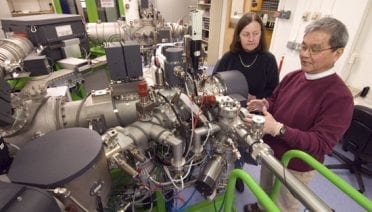Press Room
Nobumichi Shimizu Has Been Named a Fellow of the American Association for the Advancement of Science
Nobumichi Shimizu of the Woods Hole Oceanographic Institution (WHOI) has been named a fellow of the American Association for the Advancement of Science (AAAS). Election as a fellow is an honor bestowed upon AAAS members by their peers. A member…
With more than 25 percent of the planet lying between the Tropics of Cancer and Capricorn, researchers at Woods Hole Oceanographic Institution (WHOI) are taking advantage of a recent gift to expand studies from Panama to Palau and elsewhere around…
A longtime Osterville resident who loved the oceans and supported the Woods Hole Oceanographic Institution for more than four decades before he died in 2005 has left a $1 million gift to the Institution. The funds will be used for…
The Sea Urchin Genome Sequencing Consortium, a group of 240 researchers from more than 70 institutions in 11 countries, recently announced the sequencing of the California purple sea urchin, Strongylocentrotus purpuratus.
Four researchers have been recognized by the Woods Hole Oceanographic Institution (WHOI) for their contributions to ocean sciences research and engineering. All will receive funding provided by the endowed awards to support their research over periods of three to five…
WHOI scientists and colleagues at the University of Connecticut have found the first connection between mercury levels in freshwater fish and atmospheric mercury pollution, most of which is derived from fossil fuel combustion. By comparing results from large databases for…
The Large Area Plankton Imaging System, or LAPIS, is providing biologists with a new tool to study plankton to depths of 500 meters (1,640 feet). Until now, fragile gelatinous animals have been damaged or destroyed by nets, which animals can…
A 50-meter (165-foot) long coring system nearing completion at WHOI will enable paleoceanographers to reconstruct past climates back tens of millions of years and expand the coring capabilities of the U.S. academic research fleet. The Institution’s 279-foot research vessel Knorr,…
A study of ten beaked whales of two poorly understood species shows they dive much deeper and longer than reported for any other air-breathing species, a finding of particular interest since beaked whales stranded during naval sonar exercises have been reported to have symptoms of decompression sickness.
A new observation and modeling program focused on the southern Gulf of Maine and adjacent New England shelf waters could aid policymakers in deciding whether or not to re-open, develop, and manage offshore shellfish beds with potential sustained harvesting value…
How coastal communities manage risks associated with major tsunamis is an issue of global importance following the devastating 2004 Indian Ocean tsunami that killed an estimated 200,000 people and caused billions of dollars in damage in 11 nations. The issue…
One of the last remaining New England whaling ships has provided unexpected insights into the origin of halogenated organic compounds (HOCs) that have similar chemical and physical properties as toxic PCBs and the pesticide DDT. HOCs are found everywhere and…
Scientists have found new evidence that the Bering Strait near Alaska flooded into the Arctic Ocean about 11,000 years ago, about 1,000 years earlier than widely believed, closing off the land bridge thought to be the major route for human…
Scientists have found preliminary evidence that narwhals, Arctic whales whose spiraled tusks gave rise to the myth of the unicorn, produce signature vocalizations that may facilitate individual recognition or their reunion with more distant group members. Ari Shapiro, a graduate…
The Autonomous Benthic Explorer, ABE, one of the first autonomous underwater vehicles (AUVs) to routinely work in the deep ocean, has joined the U.S. National Deep Submergence Facility, providing ocean scientists with a full range of tools to explore the…
WHOI researchers will use a small, non-invasive piece of technology, the digital archival tag or D-tag, in November to tag free-ranging killer whales in northern Norway. The researchers will record the sounds and movements of these animals as part of…
Scientists from the University of Bremen in Germany and Woods Hole Oceanographic Institution (WHOI) and have found microorganisms in buried sediment on the ocean floor producing abundant supplies of the gases propane and ethane. In a report published online this…
A fleet of gliders from WHOI’s Autonomous Systems Laboratory is quietly monitoring the ocean near Monterery Bay, California as part of a month-long experiment to learn more about ocean conditions that support rich fisheries and abundant marine life. But a…
Ferries that connect Cape Cod and the islands of Martha’s Vineyard and Nantucket are taking on another role – research vessels. Woods Hole Oceanographic Institution (WHOI) biologist Scott Gallager and colleagues have installed a package of sensors on the 235-foot…
The Towed Digital Camera and Multi-Rock Coring System, or TowCam, was developed by scientists and engineers at WHOI to meet the U.S. oceanographic community’s need for an imaging and sampling system with both routine and rapid-response capabilities. TowCam was recenly…

